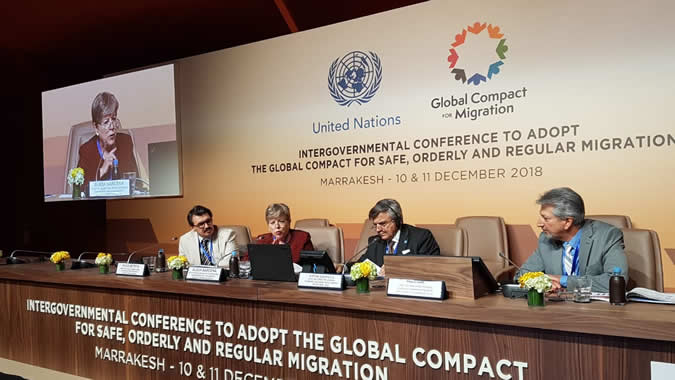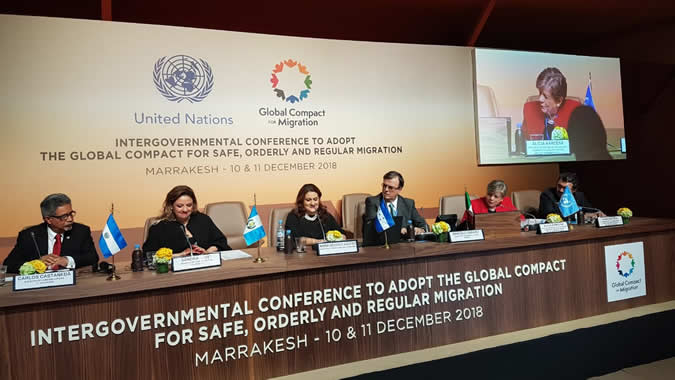Young People Under 24 from Rural Areas Constitute the Greater Part of Emigration from Northern Central America
Work area(s)
In Marrakech today, ECLAC and FAO presented a document that examines the main causes and salient characteristics of the migratory phenomenon in countries of the subregion.

Young people under 24 years of age coming from rural areas constitute the greater part of emigration from northern Central America. This according to the document Atlas of Migration in Northern Central America, launched today in Marrakech by the Economic Commission for Latin America and the Caribbean (ECLAC) and the Food and Agriculture Organization of the United Nations (FAO).
The document was presented by Alicia Bárcena, ECLAC’s Executive Secretary, and Kostas Stamoulis, Assistant Director-General of the FAO’s Economic and Social Development Department, at a press conference held in the framework of the Intergovernmental Conference on the Global Compact for Migration, which concluded today in Morocco.
During the presentation, Alicia Bárcena indicated that between 2000 and 2012 the number of people from the countries of northern Central America who live somewhere other than their places of birth rose 59%.
She affirmed that “today migration is more complex than ever in Central America. There are bigger numbers of migrants in transit, repatriated, unaccompanied minors and asylum seekers. Migration has become a matter of the highest priority on the political and development agendas.”
ECLAC’s most senior representative specified that poverty, unemployment, familial factors, the violation of rights, violence and crime, and vulnerability to climate change are the main causes of Central American migration.
Poverty is a reality. It is cruder in rural areas, where the proportion of the population that lives under this scourge has risen in recent decades, reaching critical levels, she said.
“In Honduras, the percentage of the rural population that lives in poverty totals 82%, while in Guatemala it is 77% and in El Salvador, 49%,” she affirmed.
Alicia Bárcena indicated that half of recent migrants are young people under 24 years of age, and of those, 25% correspond to children and young people under 20.
She cautioned that 180,000 unaccompanied minors were detained in the southern part of the border between 2013 and 2017. In addition, 45,000 unaccompanied minors coming from the countries of northern Central America were recorded in Mexico between 2015 and 2016.
She also warned that the number of unaccompanied girls has increased dramatically, rising by 72% in 2017 in comparison with the previous year.
For all these reasons, the senior United Nations official stressed the importance of the Comprehensive Development Plan being promoted by El Salvador, Guatemala, Honduras and Mexico, under ECLAC’s auspices.
The initiative, which seeks to promote development and opportunities in the region to contribute to preventing the migratory phenomenon while simultaneously attacking its structural causes, aspires to be the first in the region and the world to implement the Global Compact for Safe, Orderly and Regular Migration, approved on Monday, December 10 in Morocco.
Kostas Stamoulis, meanwhile, emphasized that the Atlas of Migration in Northern Central America is a significant work that confirms the excellent relationship between FAO and ECLAC.
He stated that the document is a contribution for understanding what can be done and what kind of support governments need.
Stamoulis added that the Atlas confirms that the great majority of migrants from the countries of northern Central America who depart for Mexico and the United States come from rural families that depend on agriculture for their livelihood.
For that reason, he stated, “FAO will continue working with governments with the aim of creating opportunities for rural communities and the territories that are the majority of these migrants’ places of origin.”
The Atlas of Migration brings together and organizes the best statistical data available, to contribute to the design of public policies, programs and diverse forms of action for achieving safe, orderly and regular migration in the region of Latin America and the Caribbean.
The document provides a detailed perspective on the structural causes at an economic, social and environmental level that lead to migration in the countries of northern Central America.
Related content

Foreign Ministers of El Salvador, Guatemala, Honduras and Mexico Presented Comprehensive Development Plan in the Framework of the Conference on the Global Compact for Migration
The regional initiative will change the paradigm of migration, development and cooperation between northern Central America and Mexico, under ECLAC’s auspices.

Latin America and the Caribbean vis-à-vis the Global Compact for Safe, Orderly and Regular Migration
Op-ed by Alicia Bárcena, Executive Secretary of ECLAC.
Subregional headquarter(s) and office(s)
Subregional Headquarters, MexicoType
Country(ies)
- Latin America and the Caribbean